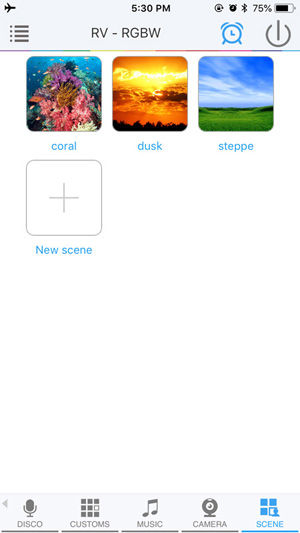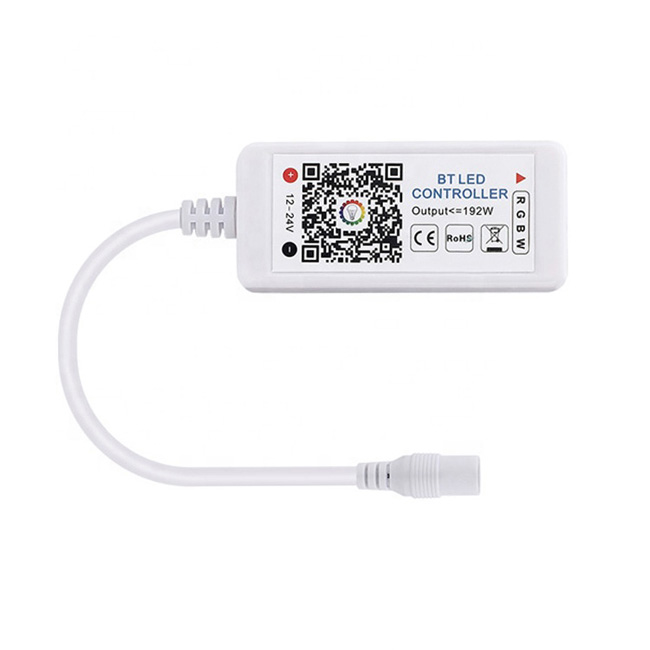 Bluetooth LED ControllerBluetooth LED controller is a short range wireless controller than can talk, via Bluetooth technology, directly to smart phones or tablets without the need of internet, and control LED strip lights and other lights through an LED controller app. Due to the ability to sync lighting with your smart phone's music, Bluetooth RGB, RGBW LED controllers are most popularly used to control RGB and RGBW LED strip lights for cars, RVs, yachts, and other vehicles Bluetooth technology is a low-cost, short-range wireless connection technology. Bluetooth LED controller works in a range up to 30 feet, without the need of line of sight. The Bluetooth singal can go through walls and work for lights in a different room. One mobile device can connect multiple Bluetooth LED controllers. Similar to the WiFi LED controller, the Bluetooth lighting control includes color management, brightness adjustment, light with audio input, and light turning on and off.
Major advantages of Bluetooth LED controllerBluetooth LED controller has two major advantages. The first advantage is that it can operate without a network such as Internet or Ethernet. Another advantage is that it can synchronize lighting with music via mobile devices such as smart phones. The combination of these two advantages makes the Bluetooth LED controller unique. When installing LED strip lights for cars, limos, RVs, yachts, boats, motorcycles, etc., Bluetooth LED controller is the best choice if you want to create casual entertaining atmosphere by synchronizing lighting with music, as you would like to play music on your smart phone when you are moving. There is no network in the vehicles, so WiFi LED controllers do not work. Bluetooth LED controller is also a great choice for strip lighting for outdoor parties, weddings, events, etc., where there is no network available but synchronization of lighting with music is a wanted feature. Bluetooth LED Controller for LED light stripBluetooth LED controller is a great choice for LED strip light applications where there is no network available. Bluetooth technology makes it very convenient to connect a mobile device to Bluetooth controller, so it is widely used to manage strip lighting over a short distance. As the Bluetooth technology is still advancing, Bluetooth LED controller has more powerful functions. The better future is still coming for Bluetooth controller to be used more and more for LED strip lighting projects. There are different types of Bluetooth controller. Below we discuss their differences, so users can have better knowledge when buying the Bluetooth LED controllers for their strip lighting projects.
Recommended Reading: Difference between Bluetooth LED Controllers for 12V and 24V strip lights1. The input voltage of the Bluetooth LED strip Controller is 12V-24V. The same controller can be used for 12V or 24V LED strips. 2. Most vehicles, such as cars, RVs, yachts, etc., have 12V system battery. So the voltage on the Bluetooth LED controller is 12V. This reminds users to choose 12V strip lights for cars, RVs and yachts. Be aware that the alternator charges battery temporarily at 13V or 14V when starting the engine, so it is better to have protection before Bluetooth controller so that the voltage change can be regulated. 3. It is worth noting the 12V or 24V output of Bluetooth LED controller. The controller is placed between the LED strip and the power supply. It does not have a transformer function, so the input voltage of the Bluetooth LED controller is its output voltage. If the power supply of the Bluetooth controller is 24V, the voltage of the light strip connected to the controller should also be 24V. If a 12V light strip is connected, it can be damaged because the 24V voltage is too high. Difference between RGB and RGBW Bluetooth LED controllersThe difference between RGB and RGBW Bluetooth LED controllers is that RGBW controller has one more color channel than RGB controller. Their ability to control strip lights is different. RGB Bluetooth controller can be used to control RGB light strips but cannot be used to control RGBW strips. RGBW Bluetooth controller is different in that it can control both RGBW and RGB LED strips. Another difference between RGB and RGBW Bluetooth LED controllers is that RGBW controllers usually have larger power than RGB controllers. Comparison of Bluetooth LED Controller and WiFi LED ControllerThe difference between Bluetooth LED controller and WiFi LED controller is that the WiFi controller requires a network such as Internet or Ethernet LAN. In order to control the LED strip lights, the mobile device and the WiFi LED controller communicate by connecting to the same network together. The Bluetooth LED controller does not need such a network. Bluetooth devices can be connected to each other directly. Both Bluetooth LED controller and WiFi controller can work as a music LED controller. Music LED controller plays music stored on your smart phones or other mobile devices, and synchronizes music with lighting changes, creating a relaxing and happy atmosphere.
Detailed difference can be found here: Differences between Bluetooth LED Controller and RF LED ControllerThe difference between Bluetooth LED controller and RF controller is that the Bluetooth controller can act as a music LED controller to play music and synchronize the music with the LED lights. This is not available with RF controllers. In other words, if you don't need to play music or sync lighting with music, the RF controller can fully meet the needs to control the RGB LED strips where there is no network available. Another difference is that RF controller usually has a larger control distance than Bluetooth LED controller. Magic Light Bluetooth LED ControllerBy explaining a Bluetooth LED controller software, we help users get to know about hwo to use the controller. The application software is the Magic Light app, so the controller is also called the Magic Light LED Controller. 1. Millions of colors for choice. At the same time, the warm white light can be adjusted to meet the needs of the scene lighting.  2. A variety of color-changing modes are stored. You can also DIY color change modes, create your favorite mode, and save it for quick recall.  3. Music sync function. Generally, our music is stored in mobile devices such as smart phones. In places where there is no network, playing music from the smart phone and synchronizing the lighting changes with the music rhythm is a major advantage of the Bluetooth LED controller.  4. Sound sync function. Bluetooth LED controller is the perfect choice for synchronizing sound and strip lighting in outdoor activities. For example, in a beautiful garden wedding, the host can synchronize the sound and lighting through the Bluetooth controller to create a happy atmosphere.  5. Scene setting function. Set the lighting scene according to your picture, being it a beautiful sunset, or a colorful garden.  6. Timed lighting control. Set the lighting to turn on at a preset time. And you can create the color or color-changing mode for the lighting, and the lighting will enter the set mode when it is automatically turned on at the preset time.  7. Multi-zone Bluetooth controller. You can freely create zones(also called groups), and assign controllers to each zone. Multiple controllers can be controlled in one zone, or each zone can be independently controlled. Save the zone combination and retrieve it at any time.  LED Controller Bluetooth TechnologyBluetooth technology is a wireless communication standard for data exchange between two mobile and/or fixed devices over short distance. It was established in the late 1990s. Compared with the popular infrared technology at the time, Bluetooth has a higher transmission speed, and does not require an interface-to-interface connection like infrared. The working frequency band of Bluetooth technology is universal, suitable for unconstrained use of users worldwide. Bluetooth solves the national border obstacle of mobile phones. Bluetooth product is easy to use. One Bluetooth LED controller can search for another Bluetooth controller and quickly establish a connection between the two controllers. Bluetooth technology has been improving from the very beginning, when it was low-speed close-range transmission, and now the transmission speed and distance have made a big leap. The Mesh network is an independently developed network technology. In the network, Bluetooth LED controllers work as signal relay stations, so they can transfer data to very large physical areas. The Mesh network is compatible with Bluetooth protocols of newer versions. Traditionally, Bluetooth LED controllers establish connection by pairing one device to another, creating a one-to-one or one-to-many micro-network relationship. In contrast, the Mesh network enables Bluetooth LED controllers to build a many-to-many relationship. Each Bluetooth LED controller in the Mesh network can send and receive information. As long as one controller is connected to the gateway, the information can be relayed between the devices, so that the message is transmitted to a position further than the normal transmission distance of the radio wave. In this way, Mesh networks can be distributed in manufacturing plants, office buildings, shopping malls, business parks and many other wider spaces, providing more stable control solutions for lighting, industrial automation equipment, security cameras, smoke detectors and environmental sensors. |









